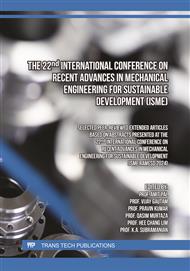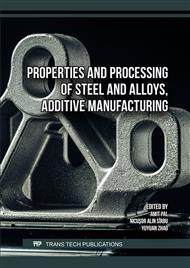[1]
S. Tahir and A. Ariffin, 'Fracture in metal powder compaction', International journal of solids and structures, vol. 43, no. 6, p.1528–1542, 2006.
DOI: 10.1016/j.ijsolstr.2005.10.010
Google Scholar
[2]
R. Jiang, Y. Song, and P. Reed, 'Fatigue crack growth mechanisms in powder metallurgy Ni-based superalloys—A review', International Journal of Fatigue, vol. 141, p.105887, 2020.
DOI: 10.1016/j.ijfatigue.2020.105887
Google Scholar
[3]
E. Ganthaler, H. MoradiMaryamnegari, T. Villgrattner, and A. Peer, 'Automatic trajectory adaptation for the control of quality characteristics in a powder compaction process', Journal of Manufacturing Processes, vol. 107, p.268–279, 2023.
DOI: 10.1016/j.jmapro.2023.09.060
Google Scholar
[4]
H. MoradiMaryamnegari, S.-E.-I. Hasseni, E. Ganthaler, T. Villgrattner, and A. Peer, 'Neural-network-based automatic trajectory adaptation for quality characteristics control in powder compaction', Journal of Intelligent Manufacturing, p.1–21, 2023.
DOI: 10.1007/s10845-023-02274-2
Google Scholar
[5]
T. H. PV Ramana, 'Process Capability (Cp & Cpk)', Six Sigma Study Guide. Accessed: May 12, 2024. [Online]. Available: https://sixsigmastudyguide.com/process-capability-cp-cpk/
DOI: 10.1201/9780203741948-2
Google Scholar
[6]
I. Zwetsloot, L. Jones-Farmer, and W. Woodall, 'Monitoring univariate processes using control charts: Some practical issues and advice', Quality Engineering, p.1–13, 2023.
DOI: 10.1080/08982112.2023.2238049
Google Scholar
[7]
H. S. Yam, 'Six Sigma: A Preamble', in Six Sigma, John Wiley & Sons, Ltd, 2006, p.1–17.
DOI: 10.1002/0470062002.ch1
Google Scholar
[8]
B. Zhong, Y. Wang, D. Wei, K. Zhang, and J. Wang, 'Multiaxial fatigue life prediction for powder metallurgy superalloy FGH96 based on stress gradient effect', International Journal of Fatigue, vol. 109, p.26–36, 2018.
DOI: 10.1016/j.ijfatigue.2017.12.006
Google Scholar
[9]
V. Indira, R. Vasanthakumari, R. Jegadeeshwaran, and V. Sugumaran, 'Determination of minimum sample size for fault diagnosis of automobile hydraulic brake system using power analysis', Engineering Science and Technology, an International Journal, vol. 18, no. 1, p.59–69, 2015.
DOI: 10.1016/j.jestch.2014.09.007
Google Scholar
[10]
N. Vivekananthamoorthy and S. Sankar, 'Lean six sigma', in Six Sigma Projects and Personal Experiences, IntechOpen, 2011.
DOI: 10.5772/17288
Google Scholar
[11]
A. Radchenko, 'Mechanical properties of green compacts. II. Effect of powder relative bulk density on the strength of compacts with different forming temperature conditions', Powder Metallurgy and Metal Ceramics, vol. 43, p.552–563, 2004.
DOI: 10.1007/s11106-005-0021-6
Google Scholar
[12]
D. J. Wheeler and D. S. Chambers, 'Understanding statistical process control', Knoxville, 1992.
Google Scholar
[13]
V. E. Kane, 'Process capability indices', Journal of quality technology, vol. 18, no. 1, p.41–52, 1986.
Google Scholar
[14]
'Control Chart Constants | Tables and Brief Explanation', R-BAR. Accessed: May 12, 2024. [Online]. Available: https://r-bar.net/control-chart-constants-tables-explanations/
Google Scholar
[15]
D. Wheeler, 'Understanding Variation: The Key to Managing Chaos (2 Revised.)'. Knoxville, TN: SPC PRESS (Statistical Process Control), 2000.
Google Scholar
[16]
D.C. Montgomery, Statistical quality control, vol. 7. Wiley New York, 2009.
Google Scholar
[17]
D.C. Montgomery, Introduction to statistical quality control. John wiley & sons, 2019.
Google Scholar
[18]
'Xbar R Chart, control chart, subgroups', Six-Sigma-Material.com. Accessed: May 18, 2024. [Online]. Available: https://www.six-sigma-material.com/Xbar-R.html
DOI: 10.1007/978-88-470-0700-0_31
Google Scholar



